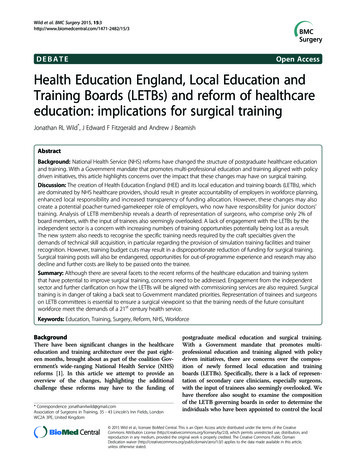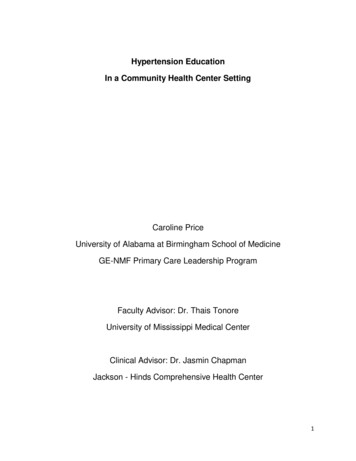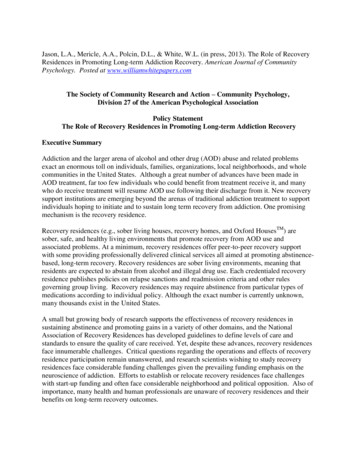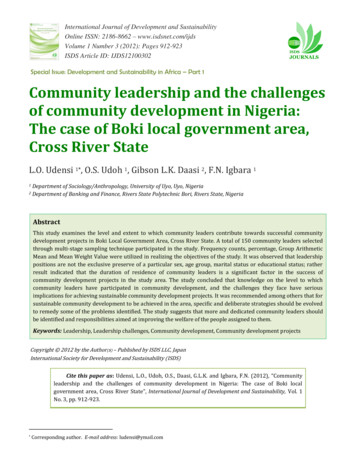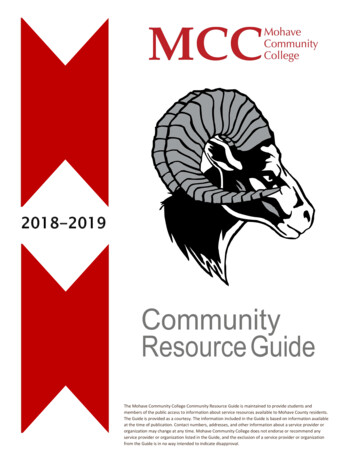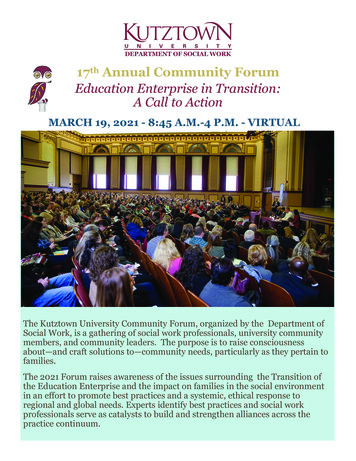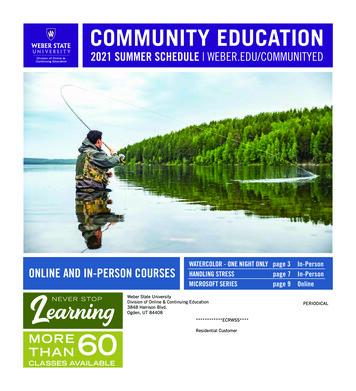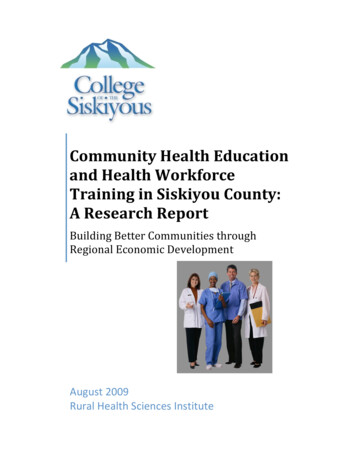
Transcription
Community Health Educationand Health WorkforceTraining in Siskiyou County:A Research ReportBuilding Better Communities throughRegional Economic DevelopmentAugust 2009Rural Health Sciences Institute
COLLEGE OF THE SISKIYOUS ADMINISTRATIONRANDALL C. LAWRENCESTEVE CROWSuperintendent/PresidentVice President of Administrative andInformation ServicesBARRY A. RUSSELL, PH.D.ROBIN RICHARDS, PHARM.D.Vice President of InstructionVice President of Student ServicesJEFF CUMMINGSDean of Career and Technical EducationBEATRIZ VASQUEZ, PH.D.Dean of Liberal Arts and SciencesBOARD OF TRUSTEESAlan DyarMarilyn HallGreg HannaJames HardyPenny HeilmanBarry OhlundBob RiceACKNOWLEDGEMENTSThis research project was completed by the consulting firm of Speranza Avram and Associates, with theassistance of Community Health Plan of the Siskiyous. The authors wish to acknowledge the significantsupport provided by COS staff, as well as various community organizations including the CommunityServices Council and the Family Resource Centers located throughout the County. The project wasguided by a Project Advisory Committee who helped shape the focus of the research study and reviewedthis report prior to its release.This document was funded by a generous grant from The Wal‐Mart Foundation and the AmericanAssociation of Community College through its Building Better Communities through Regional EconomicDevelopment Partnerships Initiative.800 College AveWeed, CA 96094530.938.5555www.siskiyous.edu
ADVISORY COMMITTEE FOR THE WAL‐MART GRANT INITIATIVEMarcia Armstrong, Supervisor, District 5 Siskiyou CountySperanza Avram, Speranza Ayram and AssociatesBarbara Baertschi, Mercy Medical CenterBetsy Bencken, Center for Virtual Care, UC DavisHealth SystemJohn H. Blossom, M.D., Cal AHEC SystemFelicia Borges, Office of Statewide HealthPlanning and DevelopmentSandie Brack, STEP, Inc.Peggy Broussard Wheeler, Calif. Hospital AssociationLori Cleveland, College of the SiskiyousJeff Cummings, College of the SiskiyousChristy Dawson, College of the SiskiyousJan Dinkel, Independent ConsultantGerri Fedora, College of the SiskiyousAudrey Flower, Madrone HospiceLisa Folberg, Center for Gov Relations, MedicalAdam Francis, CA Academy Family PhysiciansRenata Funke, College of the SiskiyousAnia Garbien, Senator Patricia WigginsKim Greene, Siskiyou ROP JPAAmy Jean Ham, CA Telemedicine and eHealth CenterAl Hernandez, Latino Coalition for Healthy CaliforniaJeanne Hough, STEP, Inc.Vicki Houle, Planned Parenthood Mar MonteErik Jacob, Ford Family FoundationDeloras Jones, Cal Instit. Nursing and Health CarePatricia Keast, Center for Health and Technology,UC Davis Health SystemBrian Keefer, CA Mental Health Planning CouncilSerena Kirk, Cal. Primary Care AssociationMichael Madden, Fairchild Medical CenterKathleen Maestas, Rural Health Policy CouncilCathy Martin, Calif. Hospital AssociationLeAnn Maupin, Oregon Institute of TechnologyPeter McKimman, Dr., Peter McKimman AssociatesElizabeth Mitchell‐Collord, Community HealthPlan of the SiskiyousNancy Mullenax, Ph.D, Welcome Back Center San FranciscoThomas Nesbitt, MD, UC Davis Health SystemSuzanne Ness, Hospital Council N/Central CaliforniaLinda Nguy, Latino Coalition for Healthy CaliforniaGail Nickerson, Adventist HealthDiane Norcio, Independent ConsultantSneha Patel, UC Davis, School of MedicineTom Riley, Cal. Academy of Family PhysiciansCaryn Rizell, CA Primary Care AssociationDesiree Rose, California Rural Health AssociationBarry Russell, Ph.D., College of the SiskiyousJudith Shaplin, Mtn Health/Community ServicesKathy Shelvock, Fairchild Medical CenterAdrienne Shilton, CA Mental Health Director AssocKathy Suvia, Northern CA AHEC, Shasta Consortium ofCommunity Health CentersNancy Swift, Jefferson Economic Development InstituteKaren Tedsen, College of the SiskiyousSusan Thomas, Northern Sierra Rural Health NetworkTina Tvedt, N. Coast Clinic NetworkAmber Wiley, Assoc. California Healthcare DistrictsHeather Young, Ph.D., UC Davis School of NursingCandi Zizek, Primary/Rural Health DivisionLinda Zorn, North/Far North Regional Health OccupationsResource Center at Butte College
TABLE OF CONTENTSBackground .1EXECUTIVE SUMMARY.2Summary of Environmental Scan .2Key Findings from the Community Survey .3Key Findings from the Rural Health Workforce Survey .4Overview of Report .6Appendix .6SECTION ONE – ENVIRONMENTAL SCAN .7Siskiyou County Demographics .7Siskiyou County Health Status.9Community Services Infrastructure.10Employment Data.10Rural Health System Characteristics.13Rural Health Workforce Continuing Education Challenges .14Rural Health Distance Learning Provider.15Expanding Role of Health Information Technology.17Healthcare Education at College of the Siskiyous .17External Partners .19SECTION TWO – COMMUNITY SURVEY RESULTS .21Source of Healthcare Information.21Information on Specific Health Conditions.22Preference for Taking a Community Class.23Sources for Community News and Information .24Internet Access .25Health Related Topics of Interest .27SECTION THREE ‐ HEALTHCARE WORKER SURVEY RESULTS .28Introduction/Methodology .28Sources for Continuing Education and Training .29SECTION FOUR – CONCLUSIONS AND NEXT STEPS .34Conclusions.34Next Steps .38APPENDICES A ‐ D.39
COS/RHSI Research ReportBACKGROUNDIn November 2005, voters in Siskiyou County overwhelmingly approved a 31.4 million bond fornew construction at College of the Siskiyous (COS), the only institute of higher learningwidespread Siskiyou County. One of the top priorities for bond‐funded projects was theconstruction of a Rural Health Sciences Institute at the College’s Yreka Campus. The RuralHealth Sciences Institute (RHSI) is an 8.8 million building designed to take advantage of thelatest e‐learning technology, including state‐of‐the‐art videoconferencing.The RHSI is scheduled to open in August, 2009. In addition to offering expanded nursing andallied health programs through traditional community college curriculum, COS leaders areexploring ways to use the RHSI to stimulate economic development within Siskiyou County. TheCollege received a grant from the Wal‐Mart Foundation as part of the Wal‐Mart WorkforceEconomic Opportunity Initiative, co‐sponsored by the American Association of CommunityColleges. COS is one of 20 community colleges in the country who are participating in this grantprogram. The COS project is called, “Building Better Communities through Regional EconomicDevelopment.”The grant funds enabled College of the Siskiyous to complete a research study determiningwhat types of external classes and programs should be offered to the Siskiyou Countycommunity in general, and rural healthcare employees specifically. The research study,summarized in this report, consisted of an environmental scan that summarizes existing dataabout Siskiyou County, its healthcare workforce, and the field of continuing education. Thestudy also sponsored two surveys: a Community Survey completed by 666 Siskiyou Countyresidents, and a Rural Healthcare Worker Survey, completed by 163 individuals who areemployed by local healthcare organizations such as hospitals and doctors’ offices.1
COS/RHSI Research ReportEXECUTIVE SUMMARYSUMMARY OF ENVIRONMENTAL SCANThe rural nature of Siskiyou County provides abundant resources that contribute positively tothe economic well‐being of the County. Businesses that focus on outdoor recreation andtourism are a major part of the employer mix, as is government employment at the local, stateand federal level. As with most rural counties, the population of Siskiyou County is older andless affluent than residents in other parts of the state.COS is the only community college and the only postsecondary institution in Siskiyou County.The College has invested in an extensive distance learning network, installing videoconferencingcapabilities in nine community locations, as well as several classrooms at its Weed and YrekaCampuses. As a result, Siskiyou County residents can take college‐level courses without leavingtheir communities. The College also offers a variety of community learning courses in‐personand online through a partnership with Ed2Go.Healthcare is one of the largest employment sectors in the County. Two hospitals, FairchildMedical Center in Yreka (north county) and Mercy Medical Center in Mount Shasta (southcounty) provide both in‐patient and out‐patient services. A web of primary care servicesconsisting of non‐profit community health centers as well as private physician practices arelocated throughout major population centers. Healthcare is one of the few employment sectorsexpected to grow over the next few years.Most healthcare workers having licenses or certificates must meet annual minimum continuingeducation (CE) requirements in order to maintain their licenses or certificates. Theserequirements can be met in a number of ways, including attendance at in‐person orvideoconferencing courses, taking online classes, or reviewing material on a CD/DVD. There arehundreds of vendors who provide CE courses through in‐person seminars, the Internet orCD/DVD. For example, Catholic Healthcare West (CHW) provides its own online CE programavailable to employees of their facilities, including the CHW hospital, Mercy Medical Center inMount Shasta.Distance learning courses offered over the Internet, videoconferencing, or CD/DVD, arebecoming an increasingly popular way for rural health providers to access CE courses. InCalifornia, the major providers of rural‐specific content include the California State Rural HealthAssociation, regional Area Health Education Centers (AHEC) located in rural communities, UCDavis School of Medicine, the California Rural Indian Health Board and the Rural HealthcareCenter operated by the California Hospital Association. Across the country, there are a handfulof CE programs focusing on rural providers. The challenge with using out‐of‐state providers isthat they may not be approved for CE units by California licensing entities.The increased utilization of technology in the delivery of healthcare will impact the field ofcontinuing education in California, including rural healthcare providers, in two key ways:2
COS/RHSI Research Report A significant growth in the number of healthcare providers who install electronichealthcare records is anticipated due to the incentives provided by the AmericanRecovery and Reinvestment Act (ARRA) of 2009. Over the next three years, close to 1,000 healthcare providers in California will beconnected to each other and to urban medical centers and universities through the newCalifornia Telehealth Network (CTN). CTN will overcome many of the connectivitybarriers that have plagued rural healthcare providers throughout California, and willprovide a high‐speed, secure broadband network that will support both clinical care andeducational services.In considering how to expand both community learning and continuing education offerings toSiskiyou County, COS has a number of existing and potential partnerships to consider as it isdeveloping its programs both inside and outside of Siskiyou County.KEY FINDINGS FROM THE COMMUNITY SURVEYThe COS Community Survey was designed to provide information that would guide theexpansion of the number and type of community classes offered through the RHSI. The surveywas distributed via the local newspaper, in schools (with the support of the Family ResourceCenters), at Wal‐Mart in Yreka, and online. 666 residents representing the major towns inSiskiyou County completed the survey. A summary of the results was reviewed at a communitymeeting held at seven different sites in the County connected by the COS videoconferencingnetwork, and at a meeting of the Project Advisory Committee. It should be noted that thissurvey was not designed as a scientific survey, but rather as a descriptive survey to provideinformation about the opinions of those individuals who chose to participate in the survey.Key findings from the Community Survey include: Almost 75% of the respondents received healthcare information from their healthcareproviders. Families and friends were the secondary source of information abouthealthcare. Wellness and healthy lifestyle were topics that respondents looked for most often,followed by information about medications. Information about heart conditions, allergies, diabetes and cancer were the highestranking specific health conditions that respondents wanted information about. Respondents preferred to take classes in‐person, followed by online and, far fewer, byvideoconferencing. 452 respondents listed 549 specific class topics in which they were interested.Information about nutrition, including weight management, was the most requestedclass topic. The top two sources for community news and information were friends and family,followed closely by local newspapers. Not surprisingly, use of the Internet as an3
COS/RHSI Research Reportinformation source was higher among younger respondents and use of the localnewspaper was higher among older respondents. Access to high‐speed Internet service varies depending on where respondents live andtheir age.The findings from the Community Survey, when analyzed in conjunction with theenvironmental scan and comments from the community, suggest the followingrecommendations regarding community education programs that could be developed at theRHSI: Become a “local trusted source” for healthcare information Develop or distribute community education classes of demonstrated interest toresidents Expand community service learning opportunities for COS/RHSI students Develop a community health resource web portal Promote existing videoconferencing capability Support regional and local efforts to expand broadband and Internet accessKEY FINDINGS FROM THE RURAL HEALTH WORKFORCE SURVEYThe purpose of the Rural Health Workforce survey was to learn more about how healthcareworkers in Siskiyou County meet their continuing education (CE) requirements, what CE topicsthey are interested in learning more about, and how they prefer to take classes. The survey wasdistributed by mail and in‐person to Siskiyou County healthcare employers. 163 individualsresponded.To supplement the survey data, four key informant interviews were held with representativesfrom the County’s largest healthcare employers, and a focus group from nine small healthcareemployers was held. Similar to the community survey, this assessment process was notdesigned as a scientific survey, but rather designed to provide information about the opinionsof individuals who chose to participate in the survey.Key findings from the online survey include: Almost 75% of the workforce survey respondents receive their CE training at work. Overhalf of the respondents indicated that they occasionally travel out‐of‐county for CEtraining, with Redding and Sacramento being the most mentioned destinations fortraining. Survey respondents indicated that it is the employee, not the employer, who most oftenpays for the costs of CE. Professional societies were the CE source most often cited by respondents followedclosely by the Internet. However, almost 60% of younger workers currently use COS as asource for professional education.4
COS/RHSI Research Report 2/3 of respondents indicated that they anticipate taking some type of training over thenext two years, with preparing for a promotion being the most cited reason for training. Regardless of their place of employment, Microsoft Windows and Office applications areused by 85% of the respondents on a daily basis. Almost half of healthcare workers useelectronic health records at least weekly. Conducting online literature searches was the most often cited health informationtechnology (HIT) training desired, followed closely by training in electronic healthrecords and health informatics.When these findings are analyzed with the responses from the key informant interviews andthe focus groups, the following recommendations are suggested for development of continuingeducation programs at the RHSI: Strengthen partnerships between COS and local healthcare employers in order to betterunderstand local needs for training. Strengthen relationships with external partners who offer value to Siskiyou Countyhealthcare workers and employers. Leverage existing investments and partnerships in health information technology toexpand locally available health information technology training opportunities for twokey audiences: new HIT workers and existing healthcare workers who require HITtraining. Create synergy between community health education efforts and professionaleducation programs in order to improve community health.Leverage the convergence of Siskiyou County’s natural beauty and abundance of alternativeand complementary health providers to develop wilder
Audrey Flower, Madrone Hospice Lisa Folberg, Center for Gov Relations, Medical Adam Francis, CA Academy Family Physicians Renata Funke, College of the Siskiyous Ania Garbien, Senator Patricia Wiggins Kim G
